The LIUniverse with Dr. Charles Liu
A half-hour dose of cosmic conversation with scientists, educators and students about the cosmos, scientific frontiers, scifi, comics, and more. Hosted by Dr. Charles Liu, PhD, an astrophysicist at the American Museum of Natural History. Support us on Patreon.
Episodes
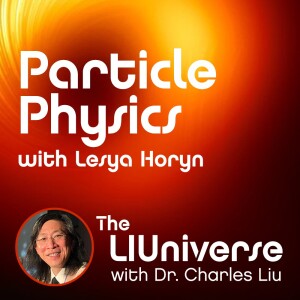
Saturday Jun 24, 2023
Saturday Jun 24, 2023
What is the universe made of? Will we ever have a complete list of all the particles that make up existence? To find out, Dr. Charles Liu and co-host Allen Liu welcome Dr. Lesya Horyn, PhD, a Fermilab researcher working at the Large Hadron Collider (LHC) at CERN in Switzerland.
As always, though, we start off with the day’s joyfully cool cosmic thing, which takes us to Brookhaven National Laboratory in Long Island, NY, where scientists have figured out how to make matter from energy. They smashed 2 photons together to produce a matter/anti-matter particle pair. It happens naturally in the universe, and we convert matter into energy all the time, but we’ve never before turned energy into matter using photons, which have no mass.
Next up, a quantum mechanics question from Lindsey in Massachusetts: “Do you believe that there is an elementary particle responsible for gravity?” Dr. Horyn explains how the standard model (the “periodic table” of subatomic particles) “makes a nice picture” but is “missing stuff” like dark matter and gravity, neither of which are in the standard model. One of these missing pieces is the graviton, a theorized elementary particle that would be responsible for gravitational force in the same way that the photon is responsible for the electromagnetic force, which Dr. Horyn and Charles both believe exists but has not yet been discovered. (Honorable mention: Our geek-in-chief Chuck mentions the Marvel Comics supervillain Graviton, who has the comic book superpower of gravity.)
Dr. Horyn explains her research at CERN, and how the LHC actually is used for experiments. You’ll learn more about the LHC, a 17-mile-circumfrence underground ring used to smash particles into each other at specific speeds, and the Compact Muon Solenoid (CMS) detector, which Lesya is using for her research now. You’ll also hear about the much larger A Toroidal LHC Apparatus (ATLAS), which she used previously for her primary research, both of which were used in the discovery of the Higgs boson ten years ago.
As Charles and Lesya take us down the particle physics rabbit hole, we end up talking about the Muon g-2 experiments eventually conducted by Fermilab. Find out why the gyromagnetic moment is important to particle physics – and yes, we go deep into the physics weeds in this episode! (Make sure to catch the story about moving a giant magnet from Brookhaven National Laboratory in New York by boat and truck to Fermilab in Illinois!)
Moving on, the crew tackles a question from Walter T. on Patreon, who asks, “Could the many worlds theory still be deterministic?” Charles explains the many worlds model, but because our existing experiments cannot distinguish between the many different models of quantum mechanics, Lesya defaults to the infamous Richard Feynman quote, “Anybody who claims to understand quantum mechanics is either crazy or lying.”
If you’d like to know more about Dr. Horyn, you can follow her on Twitter at @lesyaah. And be sure to follow @CERN, @ATLASexperiment, and @CMSexperiment to keep up with some of the developments we’ve discussed in this episode.
We hope you enjoy this episode of The LIUniverse, and, if you do, please support us on Patreon.
Credits for Images Used in this Episode:Brookhaven National Laboratory – Credit: Energy.gov, public domainParticles in the Standard Model – Credit: Cush via Wikimedia, public domainThe CMS detector – Credit: Evenkolder, CC-BY 2.0The g-2 experiment magnet in transit – Credit: Energy.gov, public domainMuonG-2 Predicted – Credit: Allen Liu, for the LIUniverseMuonG-2 Observed – Credit: Allen Liu, for the LIUniverse

Saturday Jun 10, 2023
Saturday Jun 10, 2023
We often hear about the music of the spheres, but why not the poetry of the stars? In this episode Dr. Charles Liu and co-host Allen Liu welcome poet/astronomer/cosmologist Dr. Yun Wang and poet/author Midge Goldberg, editor of “Outer Space: 100 Poems” that includes Yun’s poem, “Space Journal: Serendipity.”
As always, though, we start off with the day’s joyfully cool cosmic thing, a possible candidate relativistic tidal disruption event. Put another way, in a galaxy far, far away, a supermassive black hole at the center of the galaxy is possibly shredding a star, creating a brightening flare of radio emission. Naturally, given our guests, Chuck and company reflect on the idea of a black hole as a metaphor.
Moving on, Dr. Wang discusses her exploration of our universe and her eventual goal of modeling a billion galaxies in 3-D. She and Chuck briefly address whether universal expansion will continue forever, as some posit, and whether dark energy is truly a cosmological constant or not.
Then it’s poetry time! Midge recounts her journey to create “Outer Space: 100 Poems” and how she eventually connected with Yun, who not only contributed her own poem to the book but also translated a poem by Du Fu, who Chuck explains is one of the two greatest poets of the Tang Dynasty in China. The other is Li Bai, composer of “Night Thoughts,” the only poem Dr. Liu can recite by heart in Chinese, which he proceeds to do before also reciting the English translation he wrote.
Midge talks about choosing poems from around the world, drawn from ancient cultures up to modern day poetry about landing on the moon, and describes some of their age-old, shared themes.
For our student question, William asks, “How can poetry be used to communicate astronomy research?” Midge points to an eponymous poem about “Olber’s Paradox” she included in the book which taught her about the paradox. You’ll learn about the first scientifically reasonable answer to the paradox, which Midge points out, was written by none other than Edgar Allen Poe!
Yun explains how she almost unintentionally mingles her science and her poetry in her writing, after which she reads her poem, “Space Journal: Serendipity.” To answer William’s query, she dives into the actual science and astronomy research that is embodied in every word of her poem.
Does Chuck find an opportunity to talk about the holodecks in Star Trek, Schrodinger’s Cat, and other equally geeky subjects? You’ll have to listen to find out.
Come back in two weeks for the rest of Chuck’s interview with Dr. Yun Wang and poet/author Midge Goldberg.
If you’d like to know more about Dr. Yun Wang and her many scientific and poetic publications, see her bio page at the California Institute of Technology (Caltech): https://web.ipac.caltech.edu/staff/wang/.
To learn more about Midge Goldberg, visit her website: https://www.midgegoldberg.com/ or follow her on Twitter at @MidgeGoldberg.
“Outer Space: 100 Poems” is published by Cambridge University Press: https://www.cambridge.org/core/books/outer-space-100-poems/7D8D674BE0C7215CCC9FD0284044B819
We hope you enjoy this episode of The LIUniverse, and, if you do, please support us on Patreon.
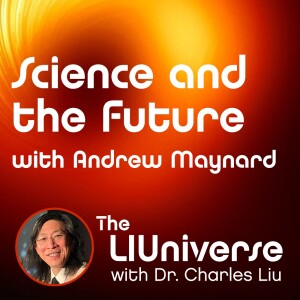
Saturday May 27, 2023
Saturday May 27, 2023
How does the science of today lead us into the future we’ve imagined? To find out, Dr. Charles Liu and co-host Allen Liu welcome scientist, futurist and podcaster Andrew Maynard, PhD from Arizona State University. Dr. Maynard’s career has taken him from physicist to futurist, with sojourns in risk analysis, nanotechnology, synthetic biology, artificial intelligence, and of course, science communication.
To begin, we travel back to Andrew’s early days studying aerosol physics, using electron microscopy to analyze minute airborne particles… like asbestos fibers. And, given the pandemic we’ve all been living through, it’s not surprising that Chuck, Allen and Andrew end up discussing the airborne particle on everyone’s mind these days: the COVID-19 virus. You’ll find out exactly how big nanoparticles are: 10,000 times thinner than a human hair!
Andrew is also a futurist, and we slide right into a discussion of nanobots, and why man-made mechanical nanobots are unlikely – the physics just don’t work at this scale – but biological molecules that behave like microscopic machines are at work right now inside each and every one of us.
Our first question comes from Stacey Severn, who is the Community Manager for The LIUniverse and a serious science fiction fan. She asks, “How plausible is it for the nanites described in “Star Trek: They Next Generation” to become real? Andrew relates the story of scientist Eric Drexler, who wrote a book called “Engines of Nature” that speculated on the possibility of creating nanites. Unfortunately, physics at the nano scale works very differently than at larger sizes.
Moving on, Chuck asks about She-Hulk, who became a green superpowered being through a blood transfusion from the Incredible Hulk. Could a transfusion cause a systemic change to a living being? Surprisingly, in principal, it’s possible. We look at gene editing using CRISPR and creating gene drives, where you can change the genetic makeup of a whole species like malaria-bearing mosquitoes.
What about finding extra-terrestrial life? Andrew puts on his risk-analysis hat to look at the possibility, and the potential risks to humanity. Andrew explains why he’s not really worried about alien diseases, but much more concerned about the hypothesis of contacting an advanced species – and not for the reasons you might expect. (Hint: we’re the danger, not the advanced, evolved aliens!)
Our next question comes from a fan named Benjy and is also related to Star Trek: Will we ever have transporter technology that can move living creatures from one place to another. We look at the digitization of information, 3-D printing, DNA replication, and the similarities to and differences from transporter technology.
Finally, Chuck asks Andrew about science communication and how to become successful on YouTube as an academic. Despite the fact that Andrew describes himself as having “no talent and no time” he started his own YouTube channel called Risk Bites, which has racked up 4 million views across all his videos, which isn’t bad for an academic channel. The key: staying focused on empowering other people to do really cool stuff.
If you’d like to know more about Andrew, check out the Mission Interplanetary podcast at ASU he co-hosts here: https://missioninterplanetary.com/.
We hope you enjoy this episode of The LIUniverse, and, if you do, please support us on Patreon.
Credits for Images Used in this Episode:– Biomolecules translating DNA into a protein – Bensaccount at en.wikipedia, CC-BY 3.0– Animation of CRISPR editing a gene – UC Berkeley, Video by Roxanne Makasdjian and Stephen McNally, Additional footage provided by Keck Graduate Institute (KGI) and Ella Maru Studio, CC-BY 2.5– Timelapse of a 3D printer – RepRapPro, CC-BY 3.0
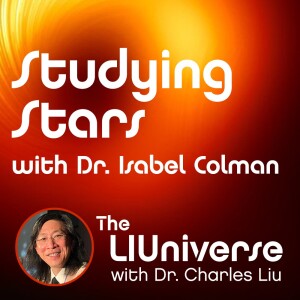
Saturday May 13, 2023
Saturday May 13, 2023
How do we study the spinning of stars? What is astroseismology? And what does data science have in common with “the music of the spheres?” To find out, Dr. Charles Liu and co-host Allen Liu welcome astrophysicist Dr. Isabel Colman, PhD, a postdoctoral fellow from the American Museum of Natural History, who studies stellar rotation through a data science perspective.
As always, though, we start off with the day’s joyfully cool cosmic thing, C/2022 E3 ZTF, aka the “Green Comet.” After Chuck regales us with the childhood classic, “Comet, it makes your mouth turn green...” Isabel explains why the presence of carbon causes the comet’s green appearance.
Moving on, our first student question comes from Thomas, who asks, “What would happen if our Sun collided with another star?” Isabel explains that the common envelope phase of stellar collisions is one of the least understood aspects of astronomy but explains how angular momentum transfer would come into play.
Chuck asks Isabel about what happens when stars spin and what’s going on with star spots. She explains how we observe stellar rotation by studying color (temperature) variations and what role magnetic activity plays in the process.
You’ll learn how she uses TESS, which was designed to discover exoplanets, for stellar astrophysics, and learn why they say, “You can’t study planets without studying stars first.” You’ll also hear about the relatively recent field of astroseismology, and why you need lots of data and time to discover repeating patterns of oscillations.
Next, we discover that Isabel is an accomplished singer, and that in high school she was both the Choir Captain and the President of the Astronomy Club. Plus, we learn about Isabel’s latest hobby, photographing and developing her own back and white images. She shares one of her recent photos of the Cloisters in upper Manhattan with Allen and Chuck. (Sorry, podcast listeners!) Circling back to astrophysics, Isabel discusses how she uses the process of image subtraction to study variable stars.
Our second question comes from Cameron, one of our Patrons on Patreon, who asks about whether the lack of oxygen in exoplanet atmospheres, which would prohibit the development of fire, would also prevent intelligent life from forming? The myth of Prometheus aside, Isabel points out that there is intelligent life in the oceans of Earth (including non-mammalian life like octopi) where there is no fire, after which she, Chuck, and Allen delve into theorizing about what kind extraterrestrial life could exist.
Finally, Isabel talks about the role of building algorithms and coding in her studies, how much she enjoys it, and why she sees it as a creative process rather than a boring, analytical one. In fact, she says that the more she learns, the more blurred the lines between technical skill and creative skill become.
If you’d like to know more about Dr. Isabel Colman and her studies and recent publications, you can visit her website at www.ilc.fyi.
We hope you enjoy this episode of The LIUniverse, and, if you do, please support us on Patreon.
Credits for Images Used in this Episode:
– Transiting Exoplanet Survey Satellite (TESS) – Orbital ATK / NASA, Public Domain
– C/2022 E3 ZTF – the “Green Comet” – Alessandro Bianconi/INAF, CC BY-SA 2.0
– A large sunspot from 2014 – NASA Goddard Space Flight Center, Public Domain
– An exoplanet light curve from JWST – NASA, Public Domain
– Kepler space telescopes: NASA/Troy Cryder , Public Domain
– CoRoT space telescopes: Blue straggler, CC BY-SA 3.0
– The Carina Nebula imaged by JWST – NASA/ESA/STScI, Public Domain
– Gaia and its map of the galaxy (Artist’s impression) – European Space Agency, CC BY-SA 3.0 IGO
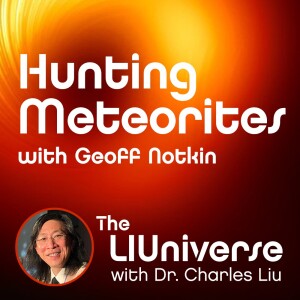
Saturday Apr 29, 2023
Saturday Apr 29, 2023
Are you ready to meet The Meteorite Man?
On this atypical episode of The LIUniverse, rather than our usual working scientist, academic or researcher guests, Dr. Charles Liu and co-host Allen Liu welcome famous meteor hunter Geoff Notkin. And he brought show and tell!
“It is a strange truth… in our world of space rocks, that meteorites, more often than not, especially the rare or super desirable ones, are in the most inconvenient places.” (Although you will hear about this one time, in 1998, when the famous meteorite hunter Skip Wilson, who found over 100 meteorites in his career, virtually had one land in his back yard in New Mexico.)
Geoff can turn the journey of a meteorite from the Moon or Mars to Earth into an action-adventure story. And when it comes to the discussion of presolar grains and chondrites, well…
Find out how Geoff turned his passion into his career, living a life of adventure and discovery, donating many of those otherworldly treasures to academic institutions, libraries and museums. He and longtime meteor hunting partner Steve Arnold were the co-hosts of Meteorite Men, which appeared on The Science Channel.
Geoff also shares his ethical and moral issues around starting and running Aerolite Meteorites, now one of the worldwide commercial leaders in the field of meteoritics. Chuck and Geoff discuss whether it’s even possible for amateurs, academics and business to co-exist in fields from paleontology to archeology, to meteoritics.
As always, we relish the day’s joyful, cosmically cool thing, and it’s a strange one: preserved cockroaches that ate moon dust are being sold at an auction. How did those roaches ingest that moon dust? You’ll have to watch to find out.*
How can we top that? Perhaps with a story about Geoff himself eating moon dust and living to tell the tale – which he does on this episode of The LIUniverse.
If you’d like to know more about Geoff, check out his YouTube channel, https://www.youtube.com/channel/UCAcGREEGQbQV3x-CnOXcXTg
We hope you enjoy this episode, and, if you do, please support us on Patreon.
*Since the recording of this episode, NASA has halted the auction of the cockroaches, exerting their ownership rights over the aforementioned moon dust.
Credits for Images or Clips Used in this Episode:
NASA's OSIRIS-REx spacecraft sampling asteroid Bennu video clip –NASA/Goddard/University of Arizona, Public Domain
Planetary accretion (artist’s impression) – ESO/L. Calçada, CC BY 4.0
A piece of the Allende Meteorite – Shiny Things, CC BY 2.0
Electron microscope image of a presolar grain – Kathryn Hynes, CC BY 2.0
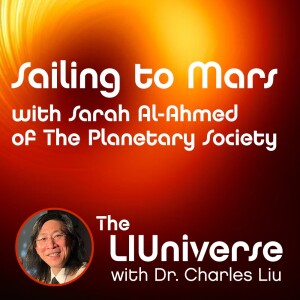
Saturday Apr 15, 2023
Saturday Apr 15, 2023
Was there ever life on Mars? Where can your passion for astronomy and cosplaying take you? And what the heck is a Light Sail?
To get the answer to these and other questions, Dr. Charles Liu and co-host Allen Liu welcome Sarah Al-Ahmed, host of The Planetary Society’s podcast, Planetary Radio.
As always, though, we start off with the day’s joyfully cool cosmic thing: a new ice-filled hole on Mars! Thanks to data from the Mars Insight Lander and the Mars Reconnaissance Orbiter, we know now that the disturbance that occurred on Mars on Christmas Eve of 2021 wasn’t a marsquake at all, but a meteor strike on the Red Planet. And the ice didn’t originate on the surface, but was kicked up by the impact.
And now that we’ve arrived at Mars, we might as well dive in. Sarah talks about the value of staged investigations of Mars, and why we shouldn’t send humans to Mars just yet. (Can you say contamination?) The conversation quickly turns to whether humans should colonize Mars, or explore it, at least at first.
For our initial student question, Anthony asks Sarah, “What date would you expect Mars to be habitable?” which we take to mean either, when was it habitable, if at all, and also, when will it be habitable? Sarah talks about the samples and science we’ve done with Curiosity, Perseverance and other missions to Mars, which point to Mars having been habitable 2-3 billion years ago, before some catastrophic change caused it to lose its atmosphere. As to the future? Sarah optimistically predicts we could have humans living in small-scale habitats within a hundred years, but it’s unlikely that we could ever make the whole planet habitable again.
Moving on, Chuck asks Sarah about her career. She talks about getting her degree in astrophysics at UC Berkeley, operating a telescope at Lick Observatory, and working with – and learning from – Alex Filippenko, noted astronomer and one of the leading scientists involved in figuring out the amount of dark energy in the universe. She followed her passion to the Griffith Observatory, where she spent 6 years sharing her love of astronomy with people of all ages from all over the world at the world’s most-looked-through telescope. Thanks to its location in Los Angeles, the Observatory is also one of the most frequently depicted in TV, and Chuck and Sarah swap stories about its appearance in Wonder Woman (the Linda Carter series) and Star Trek Voyager.
Sarah also shares another aspect of her geekdom: she’s a gamer and a cosplayer! She shows off the Razor Kitty Kraken 2 headphones and Carina Nebula JWST-image dress she’s wearing (sorry podcast listeners – they’re really cool!) and talks about how she “recharges her happiness batteries” by going to cons and cosplaying. Convention name dropping and Doctor Who citing ensues – and of course Chuck talks about The LIUniverse’s deep ties to New York Comic Con. Check out our two live Science of Sci-Fi panels from 2021 and 2022.
Next, it’s time for our second student question, from a different Anthony: “How does astronomy impact you as a person or the way you look at life?” Sarah’s answer is so powerful and empowering, we wouldn’t dream of spoiling it here – watch or listen for yourself! (Chuck’s response is pretty cool, too.)
Finally, Sarah talks about her gig at The Planetary Society, where she now hosts their Planetary Radio podcast, and all of the cool projects that are coming to fruition. You’ll learn about their new Member Community Digital App and the new Planetary Academy membership program for kids 9 and younger. Chuck and Sarah discuss the importance of The Planetary Society and its legacy. (For those of you who don’t know, Carl Sagan was one of its co-founders, and their current CEO is Bill Nye the Science Guy.) And you’ll find out about the Society’s Near-Earth Asteroid Scout mission, a solar sail cubesat that was launched on the recent Artemis 1 mission and is designed for asteroid detection and planetary defense. Sarah also gives us an update on the Society’s Light Sail 1 and Light Sail 2, the first fully crowdfunded space mission in history.
If you’d like to know more about Sarah and The Planetary Society, visit planetary.org. You can find Planetary Radio wherever you get your podcasts, or on Twitter @planrad, where Sarah will be tweeting.
We hope you enjoy this episode of The LIUniverse, and, if you do, please support us on Patreon.
Credits for Images Used in this Episode:
– New ice-filled crater on Mars – NASA/JPL-Caltech/University of Arizona, Public Domain
– Artist’s impression of Mars 4 billion years ago – ESO/M. Kornmesser/N. Risinger, CC BY 4.0
– Lick Observatory in Santa Clara County, California – Thomson200, Public Domain
– Griffith Observatory in Los Angeles, California – Plane777, Public Domain
– Concept art for the Near-Earth Asteroid Scout mission – NASA, Public Domain
– LightSail 2’s view from orbit – The Planetary Society, CC BY-SA 3.0
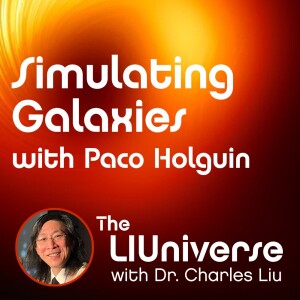
Saturday Apr 01, 2023
Saturday Apr 01, 2023
How can we create accurate models of galaxies, both ours and others? To find out, Dr. Charles Liu and co-host Allen Liu welcome Paco Holguin, a graduate researcher at the University of Michigan Dept. of Astronomy who specializes in computational astrophysics and galactic simulations.
As always, though, we start off with the day’s joyfully cool cosmic thing: neutron decay. The scientists at Los Alamos National Lab have recently determined that the half-life of a neutron is 877+/- 0.5 seconds, or about 14.5 minutes!
Moving on, Paco tells us how his love for video games and simulations led him to his field of studies, which includes the study of cosmic rays, charged particles and magnetic fields as he models galaxies. And of course, no discussion of Cosmic Rays can possibly pass without a discussion of the Fantastic Four, whose superpowers in the Marvel Comics derived from their exposure to cosmic rays.
For our first student question, Will from the Pingree School Astronomy Club wants to know about other extreme objects other than black holes and neutron stars in our galaxy. Paco starts by explaining how some types of cosmic rays, called ultra-high energy cosmic rays, qualify as extreme objects. Find out about the “Oh My God” particle, which moves so close to the speed of light that if it raced a photon across the galaxy, the photon would only be ahead by a meter after 300,000 years. (To avoid possible confusion, we’re not talking about the so-called “God Particle”, aka the Higgs boson.)
Paco explains how sometimes when he models a galaxy, it’s going along well and all of a sudden, it simply explodes. Because he uses extremely complex equations to simulate galaxies, Paco decided to take a graduate math class to better understand those equations.
Next up, Jayla from North Andover asks if there is an upper limit to the size of a black hole. As Paco and Charles discuss the possibility, agreeing that while we don’t know whether there is an actual upper limit, or we just haven’t found it yet, we have measured black holes that have billions of times the mass of our Sun.
Finally, Paco discusses what he’s been doing recently at Los Alamos, where for the past two summers he worked on machine learning projects with a diverse set of scientists and researchers. One of the projects he worked on was analyzing data from the Mars Curiosity Rover’s Chemcam using machine learning with mathematicians and computer scientists. Paco also shared with us that now that he’s finishing up his PhD, he’s off to the Applied Physics Lab at Johns Hopkins University to work on projects including exploratory space probe missions, national security issues, and more.
We hope you enjoy this episode of The LIUniverse, and, if you do, please support us on Patreon.
Credits for Images Used in this Episode:
Curiosity's Chemcam – Credit: NASA, Public Domain
Los Alamos National Labs, aerial view – Credit: Los Alamos National Labs
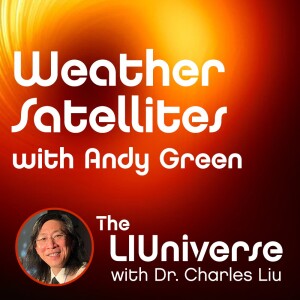
Saturday Mar 18, 2023
Saturday Mar 18, 2023
Can you turn your passion for science into a career that helps keep millions of people safe from severe weather and includes launching your own satellites into space? To find out. Dr. Charles Liu and co-host Allen Liu welcome Andy Green, the entrepreneur and self-confessed computer nerd who runs MyRadar.
As always, though, we start off with the day’s joyfully cool cosmic thing, which has to do with weather... but on another planet! We’re talking about the latest infrared image of Jupiter showing storms, auroras, and atmospheric conditions on the planet’s surface, taken by the James Webb Space Telescope and processed by a citizen scientist, Judy Schmidt, who has been doing this as a hobby for years!
Our guest, Andy Green, turned his lifelong passion for science and computers into the MyRadar app, which helps 13 million active users keep one step ahead of tornadoes, hurricanes and other severe weather that’s happening with increased frequency and severity due to climate change.
He’s the perfect person to answer our student question, which comes from Anthony: “How much impact and change do you actually see from global warming in the near future?” Unfortunately, says Andy, the answer is quite a bit, as he discusses, among other things, the increased incidences of wildfires and flooding we’re seeing on a global basis. And while weather and climate are different, Andy – who’s been staring at raw weather data for the last ten years – says, “It’s hard to escape the reality that storms have been becoming more and more severe, and the impacts from the storms have been more devastating to people.”
Next, Charles and Andy discuss how the US is the world leader in tornadoes, and whether Tornado Alley is shifting and growing over time. Andy explains how MyRadar has been expanding to offer more science education to its users, as well as better warnings for wildfires and non-weather-related events like impending earthquakes, and more. MyRadar is even launching their own satellites to provide even better data, getting them into low earth orbit via commercial space launch companies like Rocket Lab. Andy shares about how his engineers and scientists developed the MyRadar “Project Horis” nanosatellites, which will have solar panels and a suite of sensors onboard, including a hyperspectral imager, a thermal imager, and a visual camera. He even shows us one of his CubeSat prototypes and explains how they stay in orbit, what allows them to change what the satellite is pointing at, and why every newly launched satellite is required to include a deorbiting plan.
And then it’s time to geek out. Andy tells Chuck how he got into computers when he was 9 years old in the 70s with Radio Shack’s TRS-80 and has been a computer nerd ever since. He learned how to code, and fell in love with the feeling of power that gave him and set him on the course he’s still on today. He even has a Model 3, which he shows us during the video. (And if you’re just listening, don’t worry: Chuck gives you a colorful description. Can you say floppy drive?) The conversation flows from the evolution of computers and computer games, to artificial intelligence, to the benefits of augmented reality glasses and virtual reality games.
If you’d like to know more about Andy and MyRadar, go to www.myradar.com, and to hear about Project Horis, visit www.myradar.space.
We hope you enjoy this episode of The LIUniverse, and, if you do, please support us on Patreon.
Credits for Images Used in this Episode:
– Jupiter in infrared as seen by JWST – NASA / ESA / CSA / Jupiter ERS Team / Ricardo Hueso Alonso / Judy Schmidt, CC BY 2.0
– A launch of Rocket Lab’s Electron rocket – National Reconnaissance Office, Public Domain
– Rocket Lab’s launch site on New Zealand’s Mahia peninsula – Grumpy Eye, CC BY-SA 2.0
– Carving of the Egyptian god Horus 19th Dynasty, photographed by Tangopaso, Public Domain
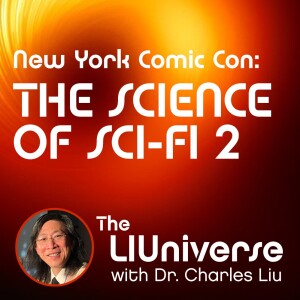
Saturday Mar 04, 2023
Saturday Mar 04, 2023
Are we all mutants? Can we all be superheroes? Is the multiverse all in our heads?
Welcome to Season 2 of The LIUniverse with Dr. Charles Liu. We’re kicking off this season the same way we did last season, with “The Science of Science Fiction” – our latest standing-room-only panel from the most recent New York Comic Con. Chuck’s guests this time around were neuroscientist and clinical psychologist Dr. Heather Berlin and geneticist Dr. Dan Ginsburg. Join us as we delve into the science surrounding three subjects: Super Genetics, Super Neuropsychology, and the Multiverse.
Segment 1: Super Genetics
Dan explains how in reality, we’re all mutants, with changes in our DNA occurring naturally in our lives. Could Horizontal Gene Transfer account for Jennifer Walters turning into She-Hulk after a transfusion from her cousin Bruce Banner, aka, the Hulk! Could a radioactive spider actually turn Peter Parker into a super-hero? After all, about 1500 genes in the human genome actually came from other species. And what about super-powered mutations due to exposure to various forms of radiation?
Find out why immortality isn’t a cure for psychosis, and why the human brain’s imperfection and constant state of change mean that the longer you live, the less like your earlier self you remain. And what would an immortal remember? According to Dr. Berlin, not nearly as much as consciously as subconsciously, and limited by the size of the hippocampus.
Heather tells us about her work on the National Academy of Sciences Science and Entertainment Exchange, where real scientists work with content creators from Hollywood to the hinterlands to inject real science into fictional worlds. (They’re even on call at 1-800-NEEDSCI!) Remember when Dr. Strange gets distracted while driving and gets into the car wreck that starts off his whole MCU journey? That was Heather!
Segment 2: Super Neuropsychology
Turning to Moon Knight, we explore the neural and psychoanalytic aspects of dissociative identity disorder (DID). Could one state of consciousness have different physical attributes or skills than another, the way Jake Lockley can speak Spanish and Stephen Grant can speak Arabic but Marc Spector, Moon Knight’s main persona, can’t really speak either? Heather talks about the actual data that proved that one person could be blind in one state of consciousness, and not the other. Dan and Heather discuss external stressors and genetic predispositions to DID and also whether different personas can interact with each other.
After that, Charles crosses from Marvel into DC to discuss Neil Gaiman’s Sandman, and how during Morpheus’ absence, people fell into a long-term, dreamless state of sleeping stupor called Encephalitis Lethargica. It turns out, it’s a real thing, and up to a million people or even more may have suffered from encephalitis lethargica for which the Spanish Flu virus may have been the triggering event. Could “long COVID” create similar responses, especially given all the mutations the COVID virus keeps generating at a more rapid rate than human biology can adapt to. And what does the immuno histocompatibility complex have to do with any of this?
Next, you’ll hear a spoiler-free discussion of the Scarlet Witch explores whether grief or other forms of emotion cause serious psychological issues? Can they cause mutation?
Of course, this wouldn’t be The LIUniverse without Chuck taking questions from our audience. Via email, Talal asks about time perception in brains, and does brain size impact our sense of time, as in when Ant-Man or the Wasp shrink to the size of an insect. Heather explains how brain size has no impact, but how a brain, human or otherwise, is wired does speed up or slow down our perception of the passage of time.
Segment 3: The Multiverse
It’s all the rage right now, especially thanks to “Dr. Strange in the Multiverse of Madness,” “Spider-Man: No Way Home,” and more, but what exactly is the current state of scientific thought around it? Astrophysicist Chuck gives us the 411 on the multiverse – why it could actually exist, with us within it, but why traveling between the universes within the multiverse like America Chavez does is still very much the realm of science fiction. To which Heather reframes the question, looking at the idea that our brain creates our subjective reality, and we can create multiple universes in our heads. (Shoutout to Michelle Yeoh and “Everything Everywhere, All at Once”!)
Our last questions come from Dr. Berlin, who asks Chuck about a version of the Drake equation for multiverses, quantum entanglement, spooky action at a distance, and how they all relate to the ideas about the multiverse; and Dr. Ginsburg, who asks about 5-dimensional constructs called membranes (M theory) and the many worlds hypothesis.
Finally, because there’s one in “the Multiverse of Madness,” we turn to the ever-popular concept of zombies. Dan tells us about infectious zombies, including how a fungus can take over its prey the way cordyceps can infect ants. Unfortunately, Heather tells us, humans are not immune, and brings up the effects of toxoplasmosis and also compares sleepwalkers with zombies.
Best panel ever? Watch and decide for yourself.
All characters and comic properties are the copyright of their respective owners.
We hope you enjoy the Season 2 premier of The LIUniverse, and, if you do, please support us on Patreon.
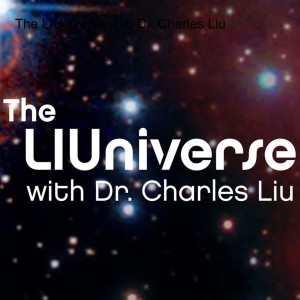
Saturday Feb 18, 2023
Saturday Feb 18, 2023
What can exoplanets teach us about our own solar system? Dr. Charles Liu explores the furthest reaches of our galaxy with the help of Vassar College astrophysicist Jackie Villadsen and co-host Allen Liu.
As always, our episode starts with the day’s cosmically cool thing: a weird and fun exoplanet system called K2-290 that’s exhibiting some crazy celestial mechanics. Find out what a K2 designation means, how the Kepler space telescope overcame a mechanical disaster, and why reaction wheels are really important! (Plus, we geek out a little bit about Star Wars and Tatooine!)
Our first student question, from Jean from New York City, “Is life possible on exoplanets?” kicks off a discussion of why we don’t know the answer yet. Jackie sums up the efforts of tens of thousands of scientists all around the globe involved in the search for life on extra-solar planets, including the different signals solar system scientists look for compared to extrasolar astronomers. You’ll hear how many exoplanets we’ve discovered already – get an update from “Future Allen” that you won’t want to miss!
Jackie shares her experiences using – and climbing all over – the Very Large Array radio telescope, the same ground-based telescope system that Jodie Foster was sitting in the movie Contact. You’ll learn about the birth of radio astronomy, coronagraphs, and why radio bursts from the sun are so intriguing. The trio talks about red dwarf stars and coronal mass ejections, including what they can tell us about our own solar system and why CMEs from our own sun could be responsible for the arid Mars we see now.
We also get to know more about Ruby Payne-Scott, the groundbreaking astronomer who, along with her colleagues, first found and categorized radio bursts from our sun in Australia after WWII. You’ll discover why she had to hide her marriage from the government in order to pursue her career. We also take one of our more interesting pop culture diversions so far, when Jackie tells us about her guilty pleasure: romance novels, including “The Ladies Guide to Celestial Mechanics” by Olivia Waite, set in the 1800s.
Finally, we grapple with a philosophical question from Walter T., one of our Patreon Patrons, that ponders existence and whether true nothingness could be possible. The answer takes us from the edge of the Big Bang to the implications of Einstein’s Theory of General Relativity and the ever-increasing space between galaxies.
We hope you enjoy this episode of The LIUniverse, and, if you do, please support us on Patreon.
Credits for Images Used in this Episode:
The Kepler satellite before launch – Credit: NASA, public domain
The Very Large Array – Credit: Wikipedia user Hajor, CC BY-SA 3.0
Total Solar Eclipse – Credit: Stephen Rahn, Public Domain
Ruby Payne-Scott – Credit: Peter Gavin Hall (Payne-Scott’s son), CC BY-SA 3.0
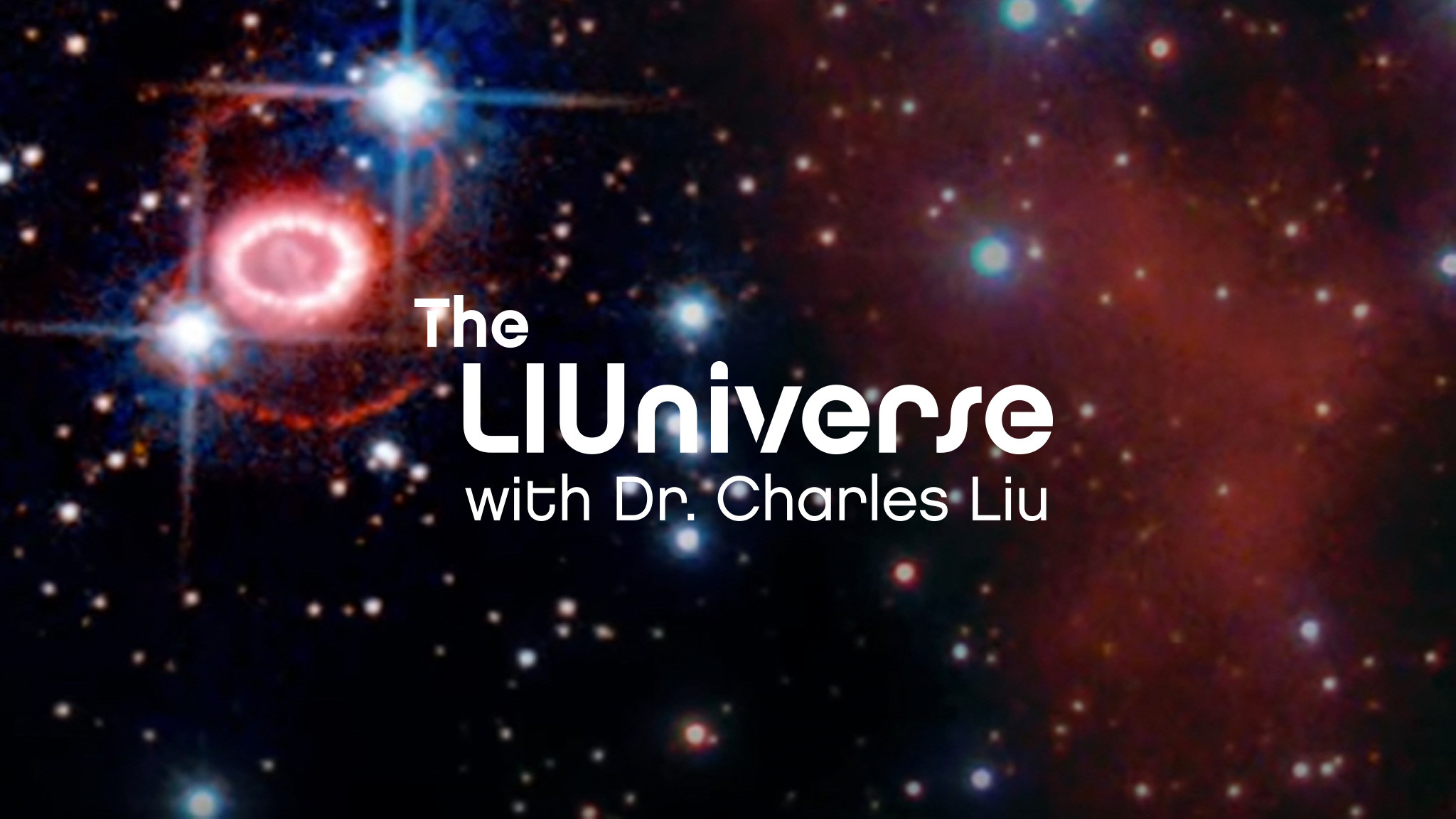
The LIUniverse with Dr. Charles Liu
Join us for a half-hour dose of cosmic conversation with scientists, educators & students on the cosmos, scientific frontiers, scifi, more. And if you love science, please support us on Patreon.
Host: Dr. Charles Liu, Astronomer
Co-host: Allen Liu, Mathematician





